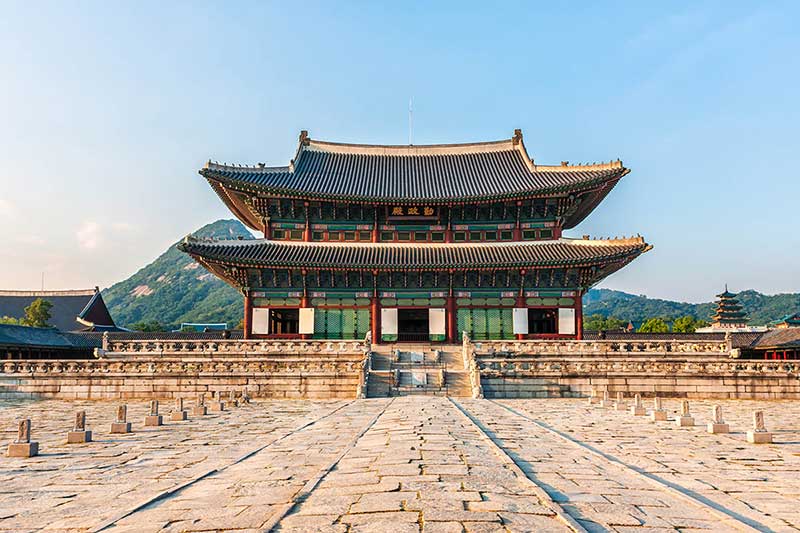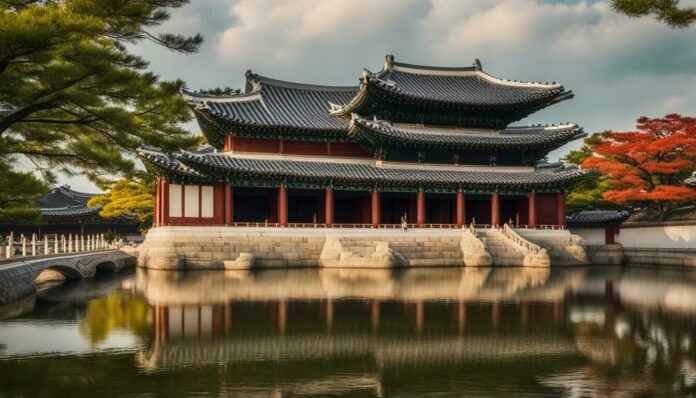Gyeongbokgung Palace stands as a testament to Korea‘s rich cultural heritage and is a must-visit for anyone wanting to explore the country’s past. Located in the heart of Seoul, this historical landmark has been a symbol of Korean history and architecture for over six centuries. The palace is a beautiful blend of traditional Korean architecture and modern restoration, making it an ideal destination for both history buffs and casual travelers alike.
Key Takeaways
- Discover the incredible history and cultural significance of Gyeongbokgung Palace.
- Explore the architectural marvels of the palace, including its gates, pavilions, and courtyards.
- Learn about the palace’s must-see highlights, such as the Geunjeongjeon Hall and the National Palace Museum of Korea.
- Embark on a virtual tour of the palace to experience its rich cultural heritage.
- Find practical information for planning your visit to Gyeongbokgung Palace, including its location, entrance fees, and opening hours.
A Glimpse into the Origins of Gyeongbokgung Palace
Gyeongbokgung Palace is one of the most iconic landmarks of Korea, steeped in rich history and cultural heritage. Its origins can be traced back to 1395 when it was constructed during the Joseon Dynasty to serve as the main royal palace. The name Gyeongbokgung means “Palace of Shining Happiness,” perfectly encapsulating its status as the center of power and prosperity.
The palace was commissioned by King Taejo, the first king of the Joseon Dynasty, as a symbol of his authority and vision for the new dynasty. Over the years, it became the primary residence of the king and his family, with various halls and pavilions added to the sprawling complex.
Despite its grandeur, the palace fell into disrepair over the centuries due to wars, natural disasters, and neglect. However, restoration efforts began in earnest in the 1990s, with the aim of preserving and reviving the palace’s former glory. Today, Gyeongbokgung Palace serves as a fascinating window into Korea’s past, a cultural touchstone that draws visitors from around the world.
Architectural Marvels of Gyeongbokgung Palace
Gyeongbokgung Palace is a spectacular architectural masterpiece that embodies the taste and precision of Korean craftsmanship. Built over five centuries ago, it is a testament to Korean tradition and culture, showcasing the ingenuity and skill of Korean builders and architects.
The palace comprises a series of structures that incorporate the traditional design elements of the Joseon Dynasty, including delicate patterns, intricate wood carvings, and vibrant colors. Visitors to Gyeongbokgung Palace can take a stroll through the palace’s courtyards, pavilions, and halls, becoming mesmerized by the palace’s architectural splendor.
Majestic Gates
One of the most admired features of Gyeongbokgung Palace is its four majestic gates. Each gate was constructed with intricate details that signify the importance of the royal court that resided within its walls. The Geunjeongmun Gate, which is the main entrance to the palace, is a grand spectacle that leads visitors into the inner sanctuary of the palace. Other gates such as the Gwanghwamun Gate and the Gyeonghoeru Pavilion are also stunning landmarks to behold.
Intricate Pavilions
Gyeongbokgung Palace is home to several stunning pavilions that boast intricate designs and exquisite carvings. The Gyeonghoeru Pavilion, located in the middle of a large pond, is a prime example of Joseon Dynasty architecture that exhibits a symmetrical design and the perfect proportion of space. The Hyangwonjeong pavilion, located near a serene pond, is recognized for its small yet elegant design that integrates naturally with its surrounding landscape.
Stunning Courtyards
The palace is designed around a series of vast courtyards that are meticulously detailed and well-maintained. Visitors can explore the Banryeong Hall, a building that was once the king’s living quarters. The hall is distinguished by its courtyard, which is surrounded by a veranda with delicate wooden latticework. Other courtyards like the Sujeongjeon Hall Courtyard are also highlights of the palace.

Unforgettable Gyeongbokgung Palace Highlights
While Gyeongbokgung Palace boasts an array of architectural wonders, certain highlights stand out as must-see attractions.
The Main Palace Buildings
The Geunjeongjeon Hall, also known as the Throne Hall, served as the backdrop for significant ceremonies and events during the Joseon Dynasty. Its grandeur is awe-inspiring, with its multiple eaves, ornate decorations, and the royal throne, which remains the centerpiece of the hall.
The Gyeonghoeru Pavilion, situated on a small island in the middle of an artificial pond, served as a venue for lavish state banquets and celebrations. Its elegant and sophisticated design features multi-tiered eaves and wooden pillars which rise straight out of the water, providing a unique and picturesque view for visitors.
The Royal Guard Changing Ceremony
The Royal Guard Changing Ceremony is a must-see spectacle which occurs three times a day in front of Gwanghwamun Gate. The ceremony reenacts the changing of the royal guards during the Joseon Dynasty and involves numerous meticulously costumed guards, horse-mounted soldiers, and a military band.
The National Palace Museum of Korea
The National Palace Museum of Korea, located within Gyeongbokgung Palace, is home to a vast collection of historical artifacts and treasures from the Joseon Dynasty. The museum showcases various aspects of traditional Korean culture, including ceramics, paintings, furniture, and textiles.
Discover these unforgettable highlights at Gyeongbokgung Palace, and immerse yourself in the rich cultural heritage of Korea.
Exploring the Rich Cultural Heritage of Gyeongbokgung Palace
Embark on a memorable tour of Gyeongbokgung Palace and discover the cultural heritage that abounds its grounds.
Begin by exploring the expansive Geunjeongjeon Hall, where the kings of the Joseon Dynasty welcomed their foreign guests and conducted important state affairs. Admire its stunning architecture, intricate details, and expansive size.
Continue your tour by visiting the Gyeonghoeru Pavilion, a magnificent structure that served as the venue for lavish royal banquets. Here, you can marvel at the unique design features that enable the pavilion to stand gracefully on water.
The National Palace Museum of Korea is another must-visit highlight. It houses a vast collection of historical artifacts that offer a glimpse into the lives of the Korean royal family and their subjects. Some of the most notable items on display include royal robes, decorative objects, and ancient texts.
As you wander around the palace’s grounds, you’ll see numerous other buildings and structures, including pavilions, gates, and gardens. Each of these is significant in its own right and tells a unique story about the palace’s history and cultural heritage.
Whether you’re a history buff, an architecture enthusiast, or simply someone who appreciates a stunning scenery, a tour of Gyeongbokgung Palace is an unforgettable experience.
Restoring the Past – Gyeongbokgung Palace Restoration
Preserving the beauty and historical significance of Gyeongbokgung Palace is of paramount importance to the Korean government. Therefore, continuous restoration work is underway to maintain and revive its former glory.
The first phase of the Gyeongbokgung Palace restoration project began in 1990 and lasted for five years. During this period, several significant structures were reconstructed, including the Geunjeongjeon Hall, Sajeongjeon Hall, and Sujeongjeon Hall.
In 2009, the second phase of the restoration work was initiated, and it is still ongoing. This phase has been more extensive and complex, as it aims to repair and restore several buildings and facilities that were severely damaged during the Japanese occupation of Korea between 1910 and 1945.
The Gyeongbokgung Palace restoration project involves a meticulous process of research, design, and implementation. Skilled artisans and experts in traditional Korean architecture and craftsmanship employ traditional methods and materials to restore the palace to its original splendor.
The restoration project is also an opportunity for visitors to learn about the rich cultural heritage of Korea and the intricate construction techniques used by the Joseon architects. The work also serves as a testament to the country’s commitment to preserving its historical sites.
Currently, several structures are undergoing restoration, including the Jangandang Hall, Gyotaejeon Hall, and Hyangwonjeong Pavilion. The restoration is expected to be completed in 2030.
Practical Information for Visiting Gyeongbokgung Palace
If you’re planning a trip to Seoul, South Korea, a visit to Gyeongbokgung Palace is a must. Here’s everything you need to know before you go:
Location and Directions
Gyeongbokgung Palace is located in the heart of Seoul, just a short walk from Gyeongbokgung Station. If you’re coming from the airport, you can take a taxi or use the Seoul subway system to get to the palace.
Entrance Fees and Opening Hours
The entrance fee to Gyeongbokgung Palace is 3000 KRW for adults and 1500 KRW for children. The palace is open from 9:00am to 5:00pm, with the last admission at 4:00pm. Note that the palace is closed on Tuesdays.
Guided Tours and Audio Guides
To make the most of your visit, consider a guided tour of the palace. You can either book a private tour or join a group tour upon arrival. Audio guides are also available for rent at the entrance.
What to Wear and Bring
As the palace is an outdoor attraction, be sure to dress appropriately for the weather. Comfortable shoes are also recommended, as there is a lot of walking involved. Don’t forget to bring sunscreen, water, and a camera to capture the breathtaking beauty of Gyeongbokgung Palace.
Other Tips
Visitors are not allowed to bring food or drink into the palace, so plan accordingly. Additionally, be sure to check the weather forecast before your visit to ensure a comfortable and enjoyable experience.
Discover the Exciting Park Attractions at Universal Studios Japan
Conclusion
In conclusion, the Gyeongbokgung Palace, with its intricate history and stunning architecture, remains one of Korea’s most beloved landmarks. The palace tells a story of the country’s rich cultural heritage, and the ongoing restoration efforts aim to preserve its legacy for generations to come.
Visitors to Seoul should not miss the opportunity to explore the palace’s many highlights, including the Geunjeongjeon Hall, Gyeonghoeru Pavilion, and the National Palace Museum of Korea. Whether you’re a culture enthusiast or simply looking for a fascinating journey into the past, the Gyeongbokgung Palace offers an unforgettable experience.
With its many fascinating facts and stories, the Gyeongbokgung Palace history stands as a testament to the resilience and creativity of the Korean people.
FAQ
What is the significance of Gyeongbokgung Palace?
Gyeongbokgung Palace is a renowned Korean landmark and holds great historical and cultural significance. It was the main royal residence during the Joseon Dynasty and is an architectural marvel.
When was Gyeongbokgung Palace constructed?
Gyeongbokgung Palace was built in 1395 during the Joseon Dynasty.
What are the architectural features of Gyeongbokgung Palace?
Gyeongbokgung Palace boasts impressive architectural elements, including grand gates, intricate pavilions, and beautiful courtyards.
What are the must-see highlights of Gyeongbokgung Palace?
Some of the must-see highlights of Gyeongbokgung Palace include the Geunjeongjeon Hall, Gyeonghoeru Pavilion, and the National Palace Museum of Korea.
Can I explore Gyeongbokgung Palace virtually?
Yes, you can embark on a virtual tour of Gyeongbokgung Palace to experience its rich cultural heritage and learn about its history.
Are there any ongoing restoration efforts at Gyeongbokgung Palace?
Yes, there are ongoing restoration efforts at Gyeongbokgung Palace aimed at preserving and reviving its historical splendor for future generations.
Where is Gyeongbokgung Palace located?
Gyeongbokgung Palace is located in Seoul, South Korea.
What is the entrance fee for visiting Gyeongbokgung Palace?
The entrance fee for Gyeongbokgung Palace may vary. Please check the official website or inquire at the ticket counter for the most up-to-date information.
What are the opening hours of Gyeongbokgung Palace?
Gyeongbokgung Palace is usually open from 9:00 AM to 6:00 PM, but it is advisable to check the official website or contact the palace directly for the current opening hours.



